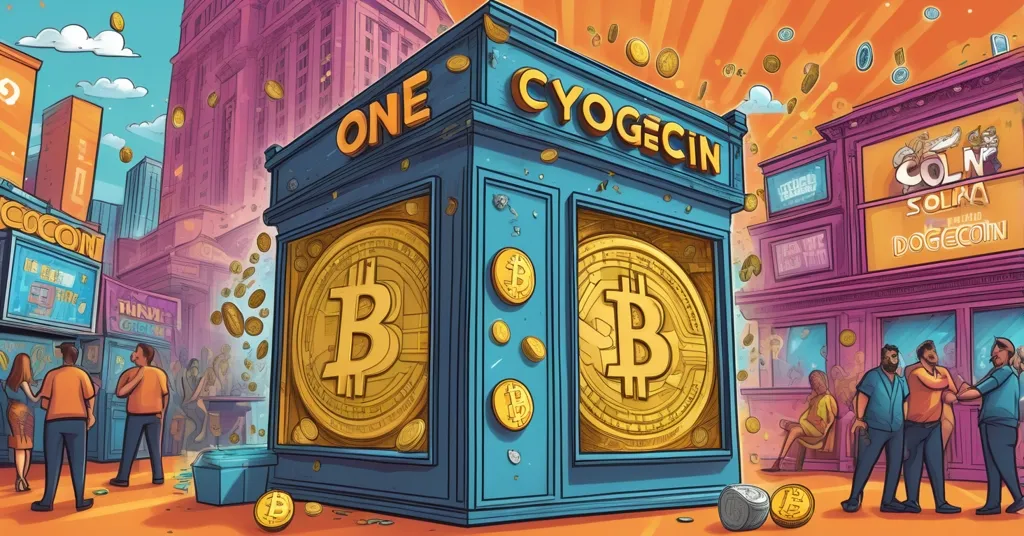Franklin Templeton ETF Adds Dogecoin, XRP, Solana; PEPENODE Hype Sparks Risky Crypto Bets

Franklin Templeton’s Crypto ETF Expands with Dogecoin, XRP, and Solana: Speculative Eyes Turn to PEPENODE’s Wild Potential
Wall Street is placing a bigger bet on crypto as Franklin Templeton, a titan of traditional finance managing over $1.5 trillion in assets, revamps its Crypto Index ETF to include a diverse lineup of digital currencies like XRP, Solana, Dogecoin, Cardano, Stellar, and Chainlink, beyond just Bitcoin and Ethereum. At the same time, the retail crowd is buzzing over riskier plays like PEPENODE, a meme coin with a gamified “mine-to-earn” twist that’s raked in millions during its presale, spotlighting the ongoing tug-of-war between institutional stability and speculative chaos in this space.
- Franklin Templeton’s Crypto Index ETF now features XRP, Solana, Dogecoin, and more, marking a broader institutional nod to altcoin narratives.
- A spot XRP ETF (XRPZ) launches, elevating XRP’s status despite past regulatory battles with the SEC.
- Speculative hype shifts to PEPENODE, an Ethereum-based meme coin with virtual mining and sky-high staking rewards, raising over $2 million in presale.
Franklin Templeton’s Bold Crypto ETF Expansion: A Milestone for Adoption
Franklin Templeton isn’t new to blockchain—since 2019, they’ve experimented with tokenized funds on networks like Stellar—but their latest move to expand the Crypto Index ETF signals a seismic shift in how traditional finance views cryptocurrency. By adding XRP, Solana, Dogecoin, Cardano, Stellar, and Chainlink to a portfolio that once leaned heavily on Bitcoin and Ethereum, they’re curating a diversified slice of the crypto market for institutional investors. This isn’t just about exposure; it’s about validating a range of blockchain use cases—from DeFi to meme-driven culture—in the eyes of pensions, endowments, and risk-averse portfolios. For those unfamiliar, an ETF (exchange-traded fund) is a vehicle that tracks the price of underlying assets, in this case holding actual cryptocurrencies (not just futures contracts), allowing investors to gain exposure without navigating the complexities of wallets or exchanges.
The significance here is twofold. First, bundling these assets into a single index fund could temper the wild price swings that define crypto, as they’re tied to steadier, managed investment vehicles. Second, it’s a stamp of legitimacy for altcoins that have often been dismissed as speculative noise by skeptics. Bitcoin maximalists—those who see BTC as the only true digital gold—might grumble that this dilutes the mission of decentralization, arguing that altcoins are often centralized distractions. But there’s a counterpoint: altcoins drive experimentation, filling niches Bitcoin doesn’t address, aligning with the ethos of effective accelerationism where rapid innovation pushes boundaries, even if it’s messy. Franklin Templeton’s play suggests they’re banking on a future where crypto isn’t just Bitcoin, but a sprawling ecosystem of specialized tech.
XRPZ: A Quiet Victory for Ripple Amid Regulatory Shadows
Perhaps the most eyebrow-raising part of this expansion is the launch of XRPZ, a dedicated spot XRP ETF. XRP, tied to Ripple Labs and designed for fast, cheap cross-border payments, has been a lightning rod for controversy due to a years-long legal battle with the U.S. Securities and Exchange Commission (SEC). The SEC sued Ripple in 2020, alleging XRP was an unregistered security, a case that dragged on until a partial win for Ripple in 2023 when a court ruled XRP isn’t a security in secondary market sales. With a market cap hovering around $30 billion, XRP’s inclusion in a spot ETF alongside Bitcoin and Ethereum is a signal that institutional players see its utility—and regulatory risks—as manageable. For newcomers, a spot ETF means Franklin Templeton holds actual XRP, giving investors direct price exposure without owning the coin.
This matters because it hints at a thawing of regulatory hostility, potentially opening doors for other altcoins under scrutiny. But let’s not pop the champagne yet—while XRPZ is a win, the SEC’s hesitance on altcoin ETFs beyond BTC and ETH remains a hurdle. Over-institutionalization could also centralize control of these assets, a bitter irony for a space born from the rejection of middlemen. Is the trade-off for stability worth risking the rebel spirit of crypto? It’s a question that lingers as Wall Street wades deeper into these waters.
Why Altcoins in ETFs Matter: A Closer Look at the Lineup
Franklin Templeton’s expanded ETF isn’t just a random grab-bag of coins; each addition reflects a unique narrative or technology that appeals to different investor appetites. Solana, often dubbed an “Ethereum killer,” offers high-speed transactions and scalability, making it a darling of DeFi (decentralized finance) projects—think apps that cut out banks for lending or trading. Cardano, with its energy-efficient proof-of-stake system, pitches itself as a sustainable blockchain for long-term infrastructure. Chainlink plays a critical role in DeFi by acting as a bridge, or “oracle,” feeding real-world data like prices into smart contracts—automated agreements on the blockchain that execute without intermediaries.
Then there’s Stellar, another cross-border payment contender akin to XRP, and Dogecoin, the meme coin born as a joke in 2013 that somehow became a cultural icon thanks to viral hype and Elon Musk tweets. Dogecoin’s inclusion raises eyebrows—how does a coin with no clear utility beyond memes fit into a serious portfolio? It’s likely a nod to its persistent community and market cap (often in the top 10), but there’s a risk it tames the wild, speculative spirit that made it a phenomenon. If meme coins trade their Shiba Inu for a suit, do they lose what made them special? Still, Franklin Templeton’s choices show they’re hedging across payments, scalability, data solutions, and cultural trends, a calculated bet on crypto’s multifaceted future.
Speculative Fever Shifts to the Fringes: Enter PEPENODE
While institutions play it relatively safe with diversified ETFs, retail investors—often risk-loving speculators—are diving headfirst into uncharted waters for the next big thing. As Bitcoin, Ethereum, and now XRP or Solana get packaged into neat Wall Street products, their explosive upside dims, pushing thrill-seekers to smaller, narrative-driven altcoins. One name catching fire is PEPENODE, an Ethereum-based meme coin that’s gamifying crypto with a “mine-to-earn” model. Unlike traditional mining, where you need pricey hardware and a hefty electric bill to validate transactions on networks like Bitcoin, PEPENODE lets users “mine” via virtual nodes—digital placeholders powered by smart contracts on Ethereum’s blockchain. It’s mining for the social media crowd: less sweat, more clicks.
The numbers are eye-popping. PEPENODE’s presale has already raised over $2.19 million, with tokens priced at a bargain-basement $0.0011638. They’re sweetening the deal for early adopters with staking rewards—where you lock up tokens to earn more over time—boasting annual percentage yields (APY) up to 589%, a figure that’s not guaranteed and screams “too good to be true.” Early participants also get more powerful virtual nodes, a clever incentive to build FOMO (fear of missing out). It blends the viral allure of meme coins with gamification trends seen in play-to-earn projects, targeting a younger, engagement-driven audience. But let’s cut the crap—projections of a 519% ROI by 2026 (price target $0.0072) and a ludicrous 1,996% by 2030 (target $0.0244) are not just speculative, they’re borderline deceptive without a shred of hard evidence. Anyone peddling such certainty in this market is likely shoveling nonsense. For more on the hype surrounding this project, check out insights on PEPENODE’s potential growth.
The Dark Side of Hype: PEPENODE’s Risks and Meme Coin Pitfalls
Let’s not get dazzled by shiny promises. The crypto space is a graveyard of hyped-up projects that burned latecomers. Meme coins like PEPENODE often surge on community buzz only to crash when the tide turns—look at the Squid Game token in 2021, a scam that vanished with millions in investor funds overnight. High APYs sound sexy, but they’re unsustainable if the project lacks real utility or if developers abandon ship, a common “rug pull” tactic. PEPENODE’s virtual mining is innovative, but there’s little transparency on the team or long-term plans. Add to that Ethereum’s notorious gas fees—transaction costs that can eat up small investments—and accessibility for everyday folks becomes questionable.
Compare this to past disasters like Terra Luna, whose high-yield promises collapsed in 2022, wiping out $60 billion in value. PEPENODE’s model isn’t identical, but the red flags of overpromised returns and hype-driven growth wave loudly. Bitcoin maximalists would argue this is why altcoins, especially meme-driven ones, are a distraction from BTC’s mission as a decentralized store of value. Yet, there’s a case for these experiments—they push boundaries and engage new users, even if most fail. The catch? You’re more likely to lose everything than strike gold. Never bet what you can’t afford to flush away.
Institutional Stability vs. Retail Recklessness: Crypto’s Duality
This split between Franklin Templeton’s cautious curation and PEPENODE’s wild gamble is the heartbeat of crypto today. On one side, you’ve got a $1.5 trillion asset manager inching blockchain tech closer to mainstream finance, potentially drawing in risk-averse demographics like retirees through pension funds or boosting adoption in emerging markets hungry for alternative investments. On the other, you’ve got retail speculators chasing lambos and moonshots, embodying the raw, chaotic energy that birthed this space. It’s not just about money—it’s ideology. Bitcoin remains the king, the beacon of freedom and privacy against a broken financial system, but altcoins keep the circus lively, for better or worse.
Here’s the devil’s advocate take: what if institutional embrace strangles crypto’s soul? If everything becomes an index fund, managed by the same suits Bitcoin was meant to disrupt, do we trade decentralization for a sanitized version of the revolution? Conversely, without retail-driven experiments like PEPENODE, would the space stagnate, missing out on cultural phenomena or niche innovations? There’s no clean answer, but the tension fuels progress—even if half the altcoins crash spectacularly.
Key Takeaways and Questions to Ponder
- What does Franklin Templeton’s Crypto ETF expansion mean for digital assets?
It signals growing institutional trust in a wider range of cryptocurrencies, potentially stabilizing prices for coins like XRP and Solana while lending credibility to altcoins in traditional finance. - Why is the XRP spot ETF (XRPZ) a significant development?
After a brutal SEC lawsuit, XRP’s dedicated ETF marks a shift in regulatory perception, suggesting contested assets might find a foothold in institutional portfolios. - How does PEPENODE’s “mine-to-earn” differ from traditional crypto mining?
It ditches physical hardware for virtual nodes on Ethereum, gamifying the process so anyone can “mine” tokens without energy costs, though its long-term value is unproven. - Are speculative meme coins like PEPENODE worth the gamble?
They can yield massive returns if timed right, but the risk of total loss is sky-high due to volatility, scams, and shaky fundamentals—proceed with extreme caution. - Could meme coins like Dogecoin lose their appeal in ETFs?
Yes, institutional bundling might curb their wild price swings, turning cultural icons into mundane portfolio assets and dimming their speculative allure. - How might ETF inclusion impact altcoin innovation?
It could legitimize altcoins, attracting developer talent and funding, but risks stifling creativity if market focus shifts to “safe” institutional picks over experimental projects. - What lessons from past meme coin failures apply to PEPENODE?
Crashes like Squid Game or Terra Luna show hype without utility often ends in disaster—PEPENODE must prove real value or risk becoming another cautionary tale.
As crypto straddles the line between Wall Street suits and rogue speculators, the path forward is anything but clear. Franklin Templeton’s ETF push brings blockchain closer to the masses, a win for adoption and stability. Meanwhile, projects like PEPENODE remind us of the untamed chaos that keeps this space electric, even if it’s a minefield. Bitcoin stands as the unshakable core of decentralization, but the altcoin frenzy—flawed as it often is—fuels the fire of disruption. So, where do you stand: building the future with sound money, or rolling the dice on the next wild bet? Keep your wits sharp—there’s no room for nonsense in this game.



